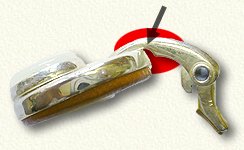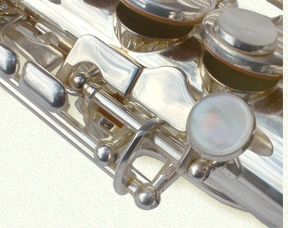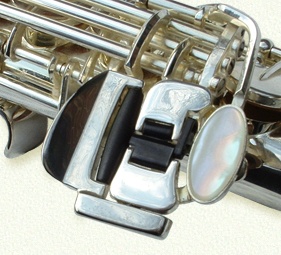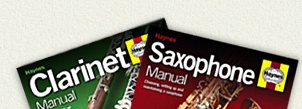Antigua A590-SPC soprano saxophone
 Origin:
Taiwan Origin:
Taiwan
Guide price: £450
Weight: -
Date of manufacture: 2005
Date reviewed: April 2005
A budget soprano that could have been so
much more...
I was very impressed with this horn on first sight. There's no
doubting that modern manufacturing methods allow even the cheapest
instruments to look rather good - and the combination of an unfussy
design, a rather baroque bell engraving and a spotless silver plated
finish make this horn look a beaut.
Of course, looks aren't everything - but as far as the bodywork
goes it matches them in terms of quality.
Nice, sturdy pillar bases - well fitted too; neat layout; two crooks
(straight and curved); substantial upper thumb rest and adjustable
lower thumb hook - and not a warped tone hole in sight.
No doubt about it, I really couldn't find anything much to fault
with the construction of the body.
I would have liked to have seen a beefier bell key cluster pillar.
As it is, it reaches nearly halfway across the top of the body -
it wouldn't take much to run it all the way and join it with, say,
one of the G# key cup pillars. This would add a great deal of strength
to a key cluster that's typically in the firing line when the horn
takes a knock or a drop.
 Things
seem to go rather badly wrong when it comes to the keywork though... Things
seem to go rather badly wrong when it comes to the keywork though...
The photo on the left shows the right hand stack E key. Look carefully
at the arrowed point where the key arm meets the cup. Notice that
gap? The key arm design is fine - but it's rather short - or the
cup has been fitted too far forwards. Essentially then, all that
holds the key cup at the correct angle is the thickness of the key
arm over that gap, and it just ain't enough.
If you think that's bad (and I do), the top B and Bis Bb keys are
much worse.
Here's the Bis Bb key arm, note how thin the key arm is above the
peak of the arc.
There are little anomalies like this dotted throughout the keywork
- and what that means is that the keywork is rather weak.
 I
think had this been a clarinet or a flute I would still have commented
on the precariously thin key arms - but this is a sax, and as such
there's more weight on the key arms, and more pressure on the keys
during use. Given an enthusiastic player - or perhaps a less than
gentle one - it's highly likely that the key arms will flex and
bend (not only from front to back, but left to right too..which
is a real cause for concern on those cups where the finger pearl
sits to one side of the cup), thus throwing out the regulation.
This is very much not a good thing. I
think had this been a clarinet or a flute I would still have commented
on the precariously thin key arms - but this is a sax, and as such
there's more weight on the key arms, and more pressure on the keys
during use. Given an enthusiastic player - or perhaps a less than
gentle one - it's highly likely that the key arms will flex and
bend (not only from front to back, but left to right too..which
is a real cause for concern on those cups where the finger pearl
sits to one side of the cup), thus throwing out the regulation.
This is very much not a good thing.
It's a pity, really, because the keys themselves are otherwise
just as well made and finished as the body.
And if you think it's something of a non-problem...well, I see plenty
of otherwise well-built horns with bent keys. Bending a key isn't
always about brute force applied once...
Whilst I'm grousing, I'm a little suspicious of the springs. They're
silver in colour, which generally means stainless steel or a nickel
alloy - but they don't look quite right somehow, leading me to suspect
that they're either cheap stainless springs, or plain steel with
the blued finish removed (which would be rather curious). In any
event they're a little on the soft side - and whilst the springing
can be tweaked to lighten the action, and that's always a good idea
on any instrument, I don't know how long they'd hold their tension.
The design and placement of the auto top F key touchpiece is awful.
As fitted, it's way too far back to be of any use and it required
a great deal of bending and adjusting just to get it somewhere functional.
Bending keys to make for a slicker action is a bona fide technique
- but there are limits as to how much and often you can bend a key
before you seriously weaken its integrity.
 On
a more positive note, there's a top G key (sitting right above the
top F# key, pictured left) - though I found it rather hard to reach
in use but that might be due to my having rather long fingers -
and the bell key spatulas (pictured right) feature a plastic swivel
link between the C# and B touchpieces, as seen on Yanagisawa horns
(from which this horn draws more than a little inspiration). On
a more positive note, there's a top G key (sitting right above the
top F# key, pictured left) - though I found it rather hard to reach
in use but that might be due to my having rather long fingers -
and the bell key spatulas (pictured right) feature a plastic swivel
link between the C# and B touchpieces, as seen on Yanagisawa horns
(from which this horn draws more than a little inspiration).
Pseudo point screws are used, and whilst these are better than parallel
points they still don't allow for as much adjustment as proper point
screws.
 The
whole outfit comes in the typical Taiwanese bog-standard black case
- it's adequate, functional, but dull. The
whole outfit comes in the typical Taiwanese bog-standard black case
- it's adequate, functional, but dull.
If it's a shame that the keywork is so frail, it's an even bigger
shame that this horns plays so well.
It really does. Gone are the days when a budget soprano used to
mean a sound like a duck being squashed - this horn has bundles
of grunt, and plenty of refinement to balance it.
Naturally, it lacks the depth of the pro range sopranos tonewise
- but hey, it lacks the price too!
It has the usual tendency for cheaper horns to sound a tad over-bright
- but certainly nothing that couldn't be tamed by the use of a mouthpiece
with a big chamber (it's worth ditching the supplied mouthpiece
- it's adequate, but rather bright. Good enough for starter, but
the horn is capable of more). More importantly, it has the typically
'ethereal' sound that a lot of people look for in the soprano sax,
the kind of sound that makes you want to go sit in the bathroom
and play winsome ballads, revelling in the echoes as you do the
classic major to minor to major switch.
And if that sounds like I enjoyed playing this horn - I did. I even
dug out my fake book and blew through a few old faves.
The key layout felt fine under the fingers (save for the top G
as mentioned before), and the action responsive enough for me not
to notice anything unduly out of place. Both the tone and the tuning
were even across the range, and even the top G sounded clean and
bright.
I tried it with a sling (there's a ring fitted), but didn't much
like the position it forced me into as regards the embouchure...and
the strap fouls the left hand thumb, which is irritating at best.
I wanted to say that this was an excellent budget horn. It has
the looks, it has the tone and the tuning, it even has the price
- but when it comes down to it there's simply no point in investing
in a horn that isn't likely to withstand being played.
As it was, I had to make a few adjustments after I'd played it a
while.
So I can't recommend this horn - but I will say this much. If the
manufacturers would address the issue of the thin key arms alone
they'd have a very smart product indeed. Whack on a set of decent
springs, tweak that Auto F key design and they'd have a killer horn
at a decent price on their hands. And so would we.
Addendum
15/01/07: I'm very pleased to see that recent examples
are very much better built with regard to the keywork, which makes
these horns well worth considering if you're on a budget.
Guidelines
for ebayers and other auctioneers
|



